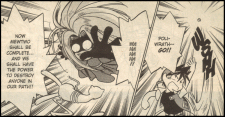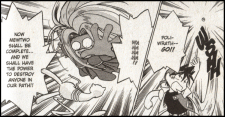



Main
Old Updates Archive
Links
 |
Lists |
List of Pokémon
Pokémon World Atlas
List of Techniques
List
of Items
List of Anime Episodes
 |
Guides |
Episode Comparisons
Movies
& Specials Guide
CD Guide
DVD Guide
Voice
Actors Guide
Lyrics Archive
Manga Guide
Video
Games
 |
Miscellaneous |
Humor
Pokémon Bashing
Features
Rants

The black
skin. The long, blonde hair. The big red lips. The
wiggly hips. Is it any wonder that people have found a racist
black stereotype in Pokémon #124, Rougela (Jynx)? Here's an
article reprinted from the "Black
World Today" website. After a brief introduction, the accusations
begin.
| Politically Incorrect Pokémon
1-5-00
I confess: I succumbed to Pokémon fever. I took my 10-year-old son to "The Pokémon Movie" during opening weekend. I suffered through the bad animation and mindless plot while he sat spellbound as the battles advanced toward a saccharine moral. When I saw the movie, I already understood the phenomenon, having bought Pokémon Red, Blue, Yellow and Pinball. Manufactured by Japan's Nintendo Corp., these digital games challenge players to collect and train 150 little pocket monsters that gain power as they evolve. If my two children are any indication, the game is incredibly fun and addictive. The fun merely begins with the game, however. Pokémon trading cards capitalize on the game's popularity. Despite my son's begging, I initially resisted investing in Pokémon cards, having bought Pogs and Beanie Babies when those fads were at their peak. So, without spending a dime, my son assembled a 60-some-card collection using duplicates donated by friends. I eventually relented and allowed him to buy a starter set, theme deck and several booster packs of Pokémon cards at prices ranging from $4 to $17. Like I said, I have submitted to Pokémania. And I would have paid a premium for the video game Pokémon Snap if only I could have found it on store shelves or e-commerce sites during the holiday shopping season. Unfortunately, Nintendo underestimated demand, and the most popular Pokémon toys were snatched up around Thanksgiving. Committed to resume my search for Pokémon Snap after the Christmas rush, I saw a character on the Pokémon TV cartoon that not only stripped the phenomenon of its innocence but stopped me cold. The character Jynx, Pokémon #124, has decidedly human features: jet-black skin, huge pink lips, gaping eyes, a straight blonde mane and a full figure, complete with cleavage and wiggly hips. Put another way, Jynx resembles an overweight drag queen incarnation of Little Black Sambo, a racist stereotype from a children's book long ago purged from libraries. While my 10- and 12-year olds do not find Jynx offensive, their parents and grandparents do. We call a spade a spade. And we have seen enough racist stereotypes to know one when we see it. There was room to debate whether "Star Wars: Episode One's" Jar Jar Binks was West Indian, but there is no question about this Pokémon character. Jynx clearly denigrates African Americans, particularly black women. At the close of the 20th century, how could Japanese computer animators unleash such a culturally insensitive menace on the global marketplace? In Asia the racist stereotypes popular before World War II apparently die hard. In 1985 when Colgate-Palmolive bought Darkie Toothpaste from Hong Kong's Hazel & Hawley Chemical Co., the new owner inherited not only a leading brand but also a racist name and logo featuring a grinning caricature in blackface and a top hat. Rival Procter & Gamble leaked news of the offensive logo to the American market, sparking protests by civil rights groups. Though Colgate eventually scrapped the Al Jolson-inspired logo and changed the brandname to Darlie, the Cantonese name-Haak Yahn Nga Gou-remains "Black Man Toothpaste." Every few years, the Japanese sense of superiority seems to resurface. For example, the Japanese fought to keep U.S. military bases in Okinawa from relocating to the mainland. And about a decade ago, a high-ranking Japanese official attributed Japan's low crime rate to the country's lack of ethnic diversity, blaming African Americans for the high crime rate in the U.S. These are strange days. Sisters in Harlem toss long tresses-courtesy of hair extensions shorn from women in Shanghai-to the beat of misogynistic raps produced by Japanese media giant Sony. So I am not surprised, though I am appalled, that a computer animator at a Japanese corporation would conceive of Jynx and that corporate executives would deem the character appropriate for multiracial markets. Even Jynx's name-a variation on the term "jinx," which means a bearer of bad luck-has negative connotations. In addition, the name Jynx suggests a link with witch doctors and voodoo, practices rooted in African religion but often ridiculed by Western culture. Pokémon is unquestionably the year's hottest toy. Since Pokémon's arrival in the U.S. in 1998, more than 7 million of the games have been sold, representing more than half of all U.S. video game revenues. Will African-American parents continue to cough up hard-earned dollars for games and trading cards featuring a monstrously racist image? Will Jynx deal Pokémon's last hand in the black community? Or will the blonde-haired, black-faced, monster evolve into an ebony princess? Stay "tooned." Carole
Boston Weatherford, a High Point, N.C. poet and children's book author,
wrote Sink or Swim: African-American Lifesavers of the Outer Banks
|
It is interesting to note the date of the article. The article was written on January 5th, 2000, less than a month after the first episode featuring Jynx, "Holiday Hi-Jynx," premiered on Kids' WB! Since that time, a number of things have happened to the character:
- Around the
time Pokémon Gold/Silver came out, the official artwork
for the
video games was changed so that Jynx's skin was purple instead of black.
- Smoochum, the pre-evolved form of Jynx, was given purple skin right off the bat. It also doesn't share the same human features that Jynx has been criticized over.
- The tape
with "Holiday Hi-Jynx"
was never given to Cartoon Network when they picked up the rights to
air the series, so the
network has never been unable to air it.
- Jynx is the only pokemon whose figure that was not available for sale at the now-defunct Pokemon Center New York.
- An episode in the Jouto seasons, "The Cave of Ice!" was banned because Jynx was a prominent character in the episode (not because of some SARS connection or any other excuse fans would have you believe). The episode's omission, though unfortunate, doesn't really affect the story at all.
- A scene featuring the black-skinned Jynx in the Pokemon Advance episode "All Things Bright and Beautifly!" is cut from the English version.
- The anime episodes dealing with the Kinagi Town Pokemon Contest features a Coordinator who uses a Rougela. However, unlike all the Rougela before it, the Rougela in this episode has purple skin. Every other Rougela who has appeared in the series since then has been the purple version.
- When Viz
released their "Best of Pokemon Adventure" compilation, they altered
the panels with Jynx in it ("The Jynx Jinx") to alter the character's
skin color. The original version is on the left while the "Best
Of" version is on the right. Click on each image to view a larger
version.
I've never thought of Jynx as a human-type pokemon! I thought it was some sort of penguin or a bear!
Yes, I've actually read someone post that on a message board once.
Aside from the fact that it doesn't look like either of those things, the pokemon is listed in the PokéDex as a "HumanShape Pokemon," both in the English and Japanese versions.
Well, what about Mr. Mime? Isn't it a stereotype of white people?
No. Unlike Rougela, Barriered (Mr. Mime) is clearly based on a mime. The clown hair, the way it performs its attacks like a mime, the pointy shoes, the rosy cheeks, the fact that it was in a circus in the anime before becoming Hanako's errand boy, etc...all give away its origin.
So the whole "Mr. Mime is based on white people" argument would only work if Caucasians were stereotyped as being mimes. Last time I checked, they weren't.
Hey, Shellder and Gastly have black faces! Let's ban them too!
Umm...no. Shellder is a clam, and Gastly is a ghost.
Besides that, Rougela's black skin is only one of the features that makes it a negative stereotype. It's the whole package that makes her a negative stereotype, not just the skin.
The problem with these "but ___ is a negative stereotype, so why haven't they been banned!?" statements is that nobody has acted on any of these. Ms. Weatherford saw a character whom she believed was a negative stereotype, and she DID something about it. She wrote a well-researched article and got it printed on a respectable news website (instead of, say, some random Pokemon fansite). Nobody's done that with, say, Lombre, which is why the character is still around today.
Jynx's doesn't have black skin; if you look at Pokemon Stadium, you can see that its face is more like a void with eyes and lips.
That's just in Pokemon
Stadium, which, at the most, can be considerd a non-canon
source. To my knowledge, this "void with eyes and lips" idea
isn't present in the anime, any of the manga, the trading card games,
or any other form of media. The thing is, it still has the wiggly
hips, the huge lips, the black hands and feet, the blonde hair, the
breasts, etc.
Jynx isn't based on black people! It's based on the Japanese ganguro fad from a couple of years ago!
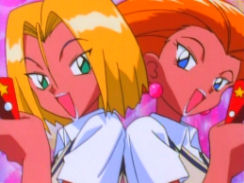 About five years
ago, there was a fad among Japanese girls
called ganguro. The ganguro, which is often
translated as "black face," was a fad in which girls would dye their
hair blonde or white and tan their skin as dark as they could get it in
an attempt to be "trendy." You can read more about it here.
There are many people out
there who are absolutely convinced that the pokemon is based on the
fad, and they will argue with you all day to argue their point.
About five years
ago, there was a fad among Japanese girls
called ganguro. The ganguro, which is often
translated as "black face," was a fad in which girls would dye their
hair blonde or white and tan their skin as dark as they could get it in
an attempt to be "trendy." You can read more about it here.
There are many people out
there who are absolutely convinced that the pokemon is based on the
fad, and they will argue with you all day to argue their point.
There are several problems with this argument. Why
would the Japanese producers pick that one particular fad to turn into
a pokemon when there are plenty of other things going around Japan that
could have just as easily been turned into a pokemon? That's like
basing a pokemon on POGs or Beanie Babies; sure, it'll get some laughs
at the time, but it won't be too long before the joke begins to show
its age.
Besides that, the date of the pokemon's conception would
predate the fad by a few years. If we are to believe the Time
Magazine article that states that Pokemon Red and Green
took six years to complete, and the game came out in 1996, then that
means that the pokemon was created some time between 1990 and 1996.
The ganguro fad was at its height in 1995, so if Tajiri
Satoshi was going to base a pokemon on the fad, then he would have only
had a year to do so. Character concepts / creation would have
been one of the first steps completed in
the creation of the game, so in 1995 the character would have already
been
long past completed. Tajiri Satoshi wouldn't have been creating
characters in 1995; he was most likely busy trying to program the game
and finding
a way to keep his company from going bankrupt month after month.
Then there are other features that link Jynx to a racist
stereotype rather than the ganguro girls; for one thing, the ganguro
girls didn't have oversized lips, and they wore white or pink
lipstick--not red. Their skin was tanned or dark brown, but they
were never jet black the
way Rougela's was. The bottoms of their feet weren't a different
color, while Jynx's feet (as seen in "Stage Fight") are a lighter color
than the rest of her.
Jynx is based on a Nordic Ice Princess!
This is the most logical argument.
People argue that the pokemon is supposed to be based on a
Viking ice princess. The argument is that the character's dress
and gloves denote the pokemon's princess origins, and its long blonde
hair scream "royalty" more than it does "black stereotype." In
addition, it would explain why the pokemon is an Ice / Psychic type,
since the princess in the myths uses ice as her main element.
Finally, it is believed that Rougela's black skin comes from a
part in the story that describes how the princess' skin is black due to
blistering cold in which she's surrounded.
While the argument makes sense, I have been unable to locate
anything regarding the tale. I've Googled over a
dozen different word combinations, but I'm unable to come up with
anything about any ice princesses. The people who argue this
haven't provided any links either, so at the moment the argument is
pretty much based on people's memory of a tale they heard a long time
ago.
So I've disproved the majority of the popular beliefs about what Rougela is based on. But now it's your turn to ask: Why would the Japanese creators base Rougela on something like Little Black Sambo? Why would they intentionally create an overtly racist character?
The answer lies in Japan's homogenous society. The country doesn't have the ethnic diversity that America has, and what the typical American thinks of as black people are pretty much non-existent in the land of the Rising Sun. Therefore, nobody's going to be upset when someone like Rougela or Dragon Ball Z's Mr. Popo appear in children's shows. To the Japanese, they're just these funny characters who appear in the movies and in rap videos. Gross overgeneralization? Perhaps, but it's been my experience that Japanese people don't have the daily contact with black people that Americans have.
 "Even
so, black people need to chill out and shouldn't get so bent out of
shape over one character." The
reason people are so upset over Jynx in the first place is because
African
Americans were some of the most cruelly stereotyped people
historically. Just take a look at some of the cartoons released
when animation was just taking off as a medium in the early 20th
century. "Sunday Go to Meetin' Time" shows a black man
constantly running into bad luck after sneaking out of church to steal
some chickens. "Scrub Me, Mama, with a Boogie Beat" has a huge
and appalling collection of black stereotypes. For a while, Tom
(the cat in Tom and Jerry) was constantly afraid of
a black maid, Mammy Two-Shoes. There are a lot more (read this Wikipedia article
for more details
about various racist cartoons), and all of them have been banned from
American
television. In fact, Cartoon Network originally intended to air
all
the Bugs Bunny cartoons for their 2001 "June Bugs" Looney Tunes
marathon,
but decided not to air eleven of the cartoons because they were so
racially
offensive.
"Even
so, black people need to chill out and shouldn't get so bent out of
shape over one character." The
reason people are so upset over Jynx in the first place is because
African
Americans were some of the most cruelly stereotyped people
historically. Just take a look at some of the cartoons released
when animation was just taking off as a medium in the early 20th
century. "Sunday Go to Meetin' Time" shows a black man
constantly running into bad luck after sneaking out of church to steal
some chickens. "Scrub Me, Mama, with a Boogie Beat" has a huge
and appalling collection of black stereotypes. For a while, Tom
(the cat in Tom and Jerry) was constantly afraid of
a black maid, Mammy Two-Shoes. There are a lot more (read this Wikipedia article
for more details
about various racist cartoons), and all of them have been banned from
American
television. In fact, Cartoon Network originally intended to air
all
the Bugs Bunny cartoons for their 2001 "June Bugs" Looney Tunes
marathon,
but decided not to air eleven of the cartoons because they were so
racially
offensive.
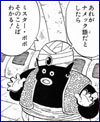
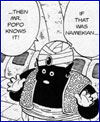
But don't think for
a minute that Rougela is the only character being picked on. In
May
of that same year, another article surfaced about both Rougela and Mr.
Popo
(from Dragon Ball Z) that was brought to my attention through
the famous Dragon Ball Z
fansite, DBZ Uncensored. The article, which repeats some of the
same
arguments from the first article, added Mr. Popo into the mix, proving
that the ice pokemon isn't the only character being targeted by the
media. While Mr. Popo is too embedded in the Dragon Ball Z
storyline to erase
(unlike Rougela), American localizers have found a way to censor the
character. In early 2004, Viz, the company that translates and
publishes the English language version of the Dragon Ball manga, began
to digitally reduce the
size of Mr. Popo's lips in an effort to soften its racist image (click
on
the images, provided by Kanzenshuu, to see larger
versions). And in February 2004, a Spongebob Squarepants valentine was
recalled because a printing error caused it to resemble the Little
Black Sambo a
little too closely.
The debate
that Mrs. Weatherford started all those years ago was that, despite the
pokemon's supposed origin or character model, the end product still
resembles African American stereotypes a little too much. Was Mr. Popo
based on a black person? No, but it's still close enough to the old
stereotypes to be offensive to some people. Were the misprinted
Spongebob valentines based on a black person? No, but it's still close
enough to the old stereotypes to be offensive to some people.
Was Jynx based on a black person? No, but it's still close enough to
the old stereotypes to be offensive to some people. That's why
the character's caused so much controversy.
Found an error or omission? Please help me keep this page current and error-free by e-mailing me with a description of the issue.


